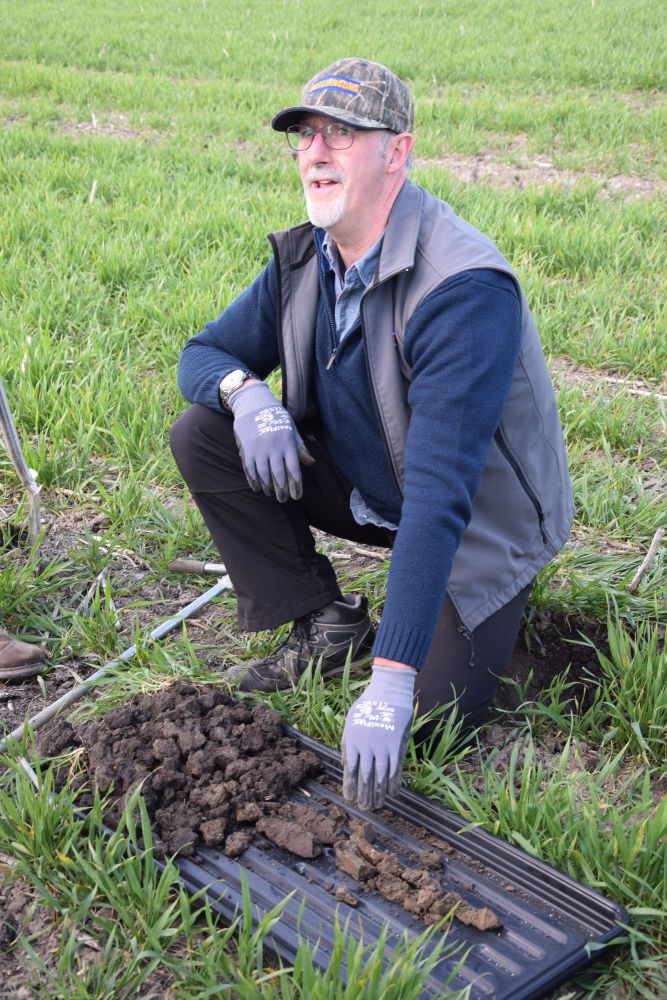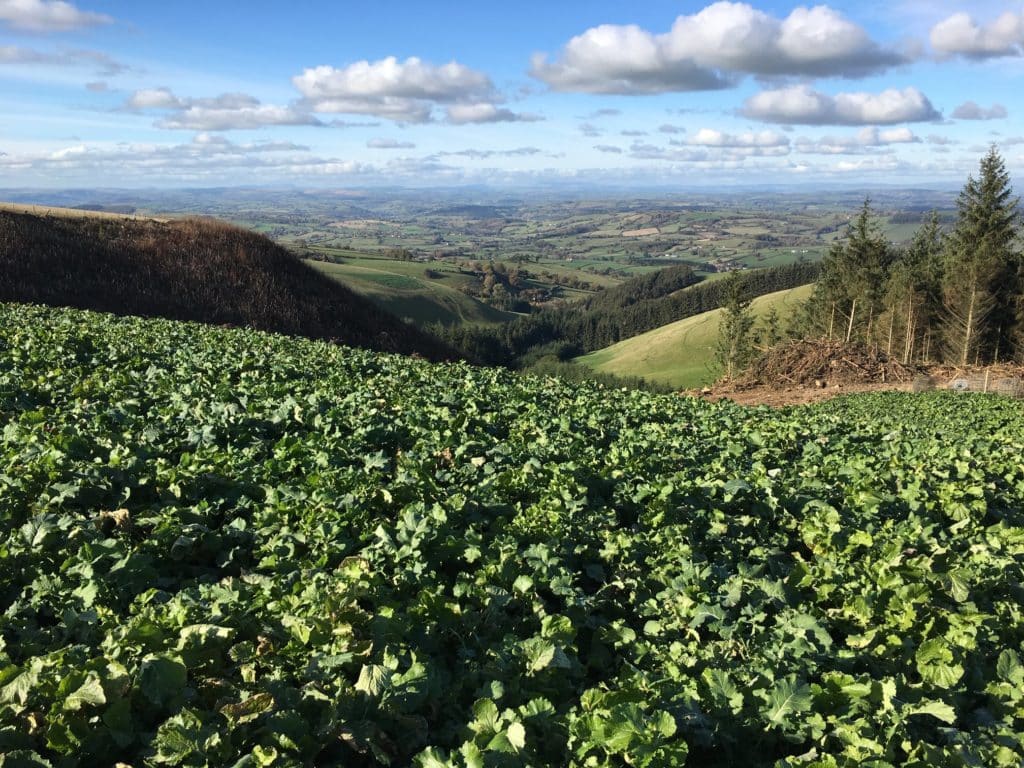Digging for answers to soil structure challenges – Arable Farming – Dick Neale
This season’s difficult conditions may have stored up problems for future crops, but close examination of soils can offer guidance on how to address any issues ...
The trials and tribulations of the 2019/2020 season will live long in the memory, as initially welcome autumn rain turned into an establishment nightmare.
Compaction from repeated attempts to cultivate and drill in autumn and spring could potentially impact future crops and soil health itself but identifying and repairing damage will pay benefits.
Examining soil condition is key
Examining soil condition is key, suggests Hutchinsons technical manager Dick Neale.
He says: “Most people’s experience was of having such a considerable amount of rain that they could not get onto the land, soil couldn’t drain and water was lying on the surface, but it might not be as bad as you think. The first course of action is to get a spade and check the condition of the soil below the surface”
He points out where it was not possible to get seed in, either with direct drills or with plough and power harrow-based systems, it was not necessarily down to previous soil management.
“In some parts of the country non-stop rain from September to February overwhelmed all systems. But when you dig down now there may be no evidence of lasting damage.”
Even heavily tilled soils and fine seedbeds may have only seen an impact in the top 8-12cm, and not to depth, Mr Neale suggests.

Dick Neale, Technical manager
“It is tempting to get out the subsoiler or mole plough, but it may not be needed-compaction could be just on the surface. If you do find a plough pan, you can address it, but dry and hard surface soils can be fixed with tillage to a depth of 5cm.”
He says that some soils, such as impermeable clays, may have remained too wet to work this spring and need to be allowed to dry out.
“Establish a cover crop by early June, picking the right day to cultivate and drill, and being careful to just tickle the top rather than pulling up wet soil.”
Cover crop
Choosing the right cover crop is essential, adds Mr Neale.
“Tight soils at 15cm that are plasticine or wet should not be subsoiled as they will smear, but a deep rooting cover crop can help to dry the soil out and restructure it. If the soil has capped but is okay underneath, break the cap with the drill and establish a cover crop with a finer root system which will stabilise the top few centimetres.
The following crop plan also helps to determine what is needed from the cover crop.
“If you are looking to build fertility for the following wheat crop, legumes are best, or you may want the roots to store up nutrients. Always look for a multispecies cover crop mix, ideally six to eight species.”
Mr Neale cautions against leaving fields bare if winter and spring crops have failed.
“Many farmers are just hoping to get a really good crop of winter wheat in for 2020/2021, but really wet soils can be costly to remedy mechanically. A well-chosen cover crop will pump water out for you.”
The Kverneland Group’s David Holmes agrees that monitoring what goes on with soil below the surface is crucial to getting crops away, enabling farmers to target operations that restructure and aerate soil, and allowing water, nutrients and roots to pass through the profile.
“Checking the soil profile will help to decide at what depth and which practice to use such as plough, tines, discs or subsoiler, to help establish crops,” he says.
“More aggressive operations such as subsoiling have been effective this spring in repairing deep compaction, for example after root crops. But having a choice of implement with interchangeable tools flexible enough to operate at varying depths and in different conditions is an advantage.”
Mr Holmes suggests while planting a cover crop could assist with removing compaction and improving soil structure, sometimes the pressure on soil is such it can’t be rectified by biology and may need mechanical remediation. Where the 2019/2020 crop will be brought to yield, preparations for the next season should start pre-harvest, he says.
“Get the spade in the ground in late June or early July and have a look at how root development has gone. Check for areas of compaction from last year’s harvest and cultivations or from this spring’s establishment, so you know what you need to do after harvest. Also consider harvest management, reducing traffic where possible and choosing good tyre equipment, especially on land which could still be wet underneath.”
If the dry period continues, natural cracking of the soil may occur, especially on heavy soils, he adds.
Fissures
“It is an indication of natural fissuring, but the cracks can close up after rain, so aim to fracture and rearrange fissures mechanically, allowing unobstructed movement of water and nutrients, as well as root growth.”
Checking soil condition below the surface will also identify the level of operation needed.
“This spring a lot of ground has appeared workable on the surface, but was very wet 10-20cm down. Do you need to just work the surface or are you looking to repair compaction? This will guide the choice between low disturbance tines or traditional subsoiling legs.”
Mr Holmes suggests assessing the soil profile will also determine how it may drill.
“Conditions are increasingly less predictable. Consider how your practices will affect soil structure and ensure you are able to work produce a seedbed that is weatherproof and safe, he says.
“When specifying machinery, it needs flexibility to meet these requirements, as you may want to work in spring and autumn; in wet and dry conditions; or in bare land, residues or standing cover crops.”
In the field
Farming near Woodhall Spa, Lincolnshire, DK Busby grows potatoes on rented sand land and cereals in the Fens, alongside a beef enterprise.
David Busby explains: “We would normally cultivate a lot of the ground in autumn but were just unable to get on-we have been moving more to min-till and it’s not a situation we’d ever experienced.”
With water lying in the fields as spring arrived, Mr Busby was advised by David Holmes to dig down and have a look at the soil condition below the surface.
“It wasn’t too bad-there was no real compaction although the surface was too solid to combi-drill. It was workable down to 20cm, below which it was waterlogged.”
Cultivator
Instead of ploughing and risking pulling up wet soil, he decided to work the top 20cm with a Kverneland DTX cultivator, lifting and moving the soil, which could then be followed with the combi drill.
“The spring barley went in surprisingly well, although it was a challenge putting 70ha in with a 3m drill, so some was drilled later than would be ideal,” says Mr Busby.

